CHIRPing bottom all the way to Bermuda, maybe fish too!
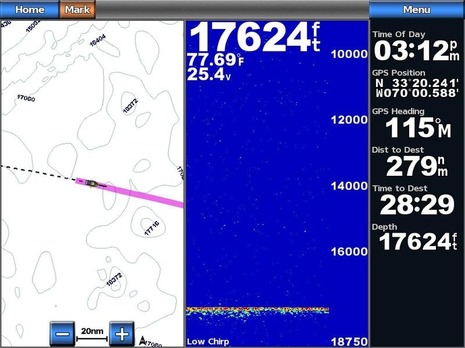
It's a rare day when someone calls to say he's sending marine electonics screenshots that gave him goosebumps! The someone was Peter Braffitt of Gemeco Marine and Airmar Technology, and while he certainly has a business interest in high-performance sonar transducers, he's also a straight shooter. Besides, isn't that screen above pretty darn amazing? It was taken aboard the handsome 80-foot Merritt-built sport fishing boat Speculator en route from Beaufort, North Carolina, to Bermuda. They not only held bottom the whole way -- even in 17,624 freakin feet of water (or 5,372 meters or 3.3 miles)! -- but they may have spotted fish at great depths too...
Garmin posted a blog about the Bermuda trip yesterday and it's quite an interesting read. The writer -- who is a Garmin sonar engineer, I think -- describes their excitement as they realized they could easily break their former record of 11,720 feet and they were headed toward depths far greater, as I was able to model nicely using Nobeltec Trident TZ below...
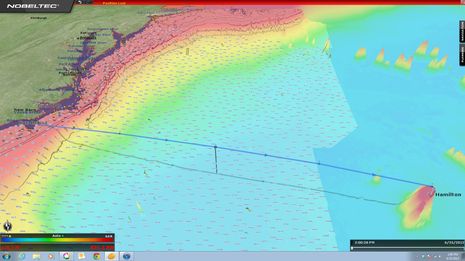
And, sure enough, they were not only holding bottom at the deepest part of their trip, but they only had the gain at 65%, or as the engineer wrote "No sweat and with many dB of signal to spare..." I know that other CHIRP sonars are seeing deep but I think this super deep performance may be due to the extra horsepower Garmin has built into its GSD 26 (like those "25-3,000 W rms")...
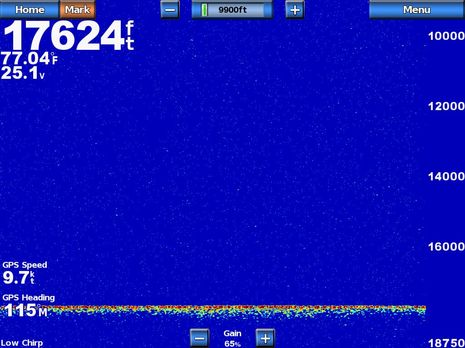
Of course the transducer has a lot to do with realized power and performance too, and in this case it was an Airmar CM599LH which was "custom installed into a sleek keel pocket that was fabricated by Bayliss Boatworks" according to Peter Braffit. Apparently the whole project was a joint developement effort by Airmar, Garmin, and Speculator's captain Ed "Cookie" Murray, though Peter assured me that no prototype hardware or beta software was involved in the results seen on these screens. (I can't find much detail about Speculator, but check out Merritt's Boat & Engine Works for more about these remarkable fishing machines.)
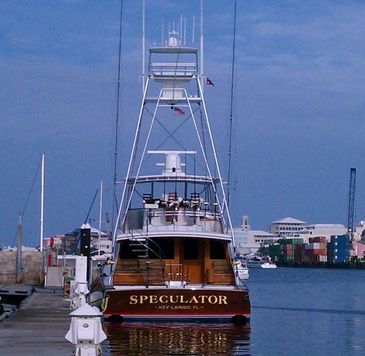
It seems quite likely that these screens will get a lot of attention from the highline fishermen competing in events like the Bermuda Triple Crown. There's a general notion -- which I pretty much buy -- that a fishfinder that can see well deep can also see really well in shallower conditions. For instance, I've seen both the GSD 26 and Simrad's BSM-2 resolve high detail of wrecks and fish just off Miami (and I saw similar with a Raymarine CP450C at last winter's shows). But how much detail can they see deep? Specifically, how far down can you see fish? Simrad likes to show off a CHIRP screen of a swordfish chasing squid at almost 2,000 feet deep off Mexico -- purportedly verified by catching the fish! But could those be fish clustered over a sea mount at about 16,000 feet deep in that Speculator screen below? I'm not sure, and given that Garmin didn't mention it in their blog entry, maybe they're not sure either. What do you think?
Either way, though, Garmin and Airmar (who are also working together on the "tunny" expedition in Scotland) deserve congratulations for breaking new ground in sonar performance. Or as Braffit wrote me "I can't help but think that we have just witnessed a new chapter in fishfinding technology."
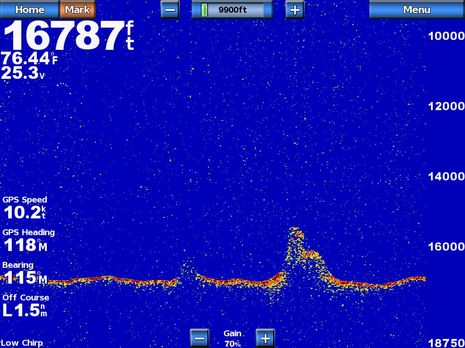

 Share
Share
Ben, I'm betting it isn't a fish, although I would like to think so. Given the cone width at that depth, and the apparent scale of the structure/fish it would have to be huge. That being said, the Kraken has to live somewhere.